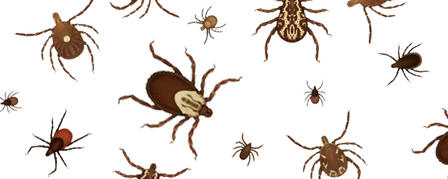TICKS ARE OUT, BE IN-THE-KNOW

May 15, 2014
Kansas’ ticks can be active until midsummer or later
PRATT – Ticks are stealthy, opportunistic arachnids that make their debut in spring just as temperatures begin to rise. How to prevent becoming a host to these hitchhikers and the various diseases they may carry isn’t a mystery, but it has to be methodical. Here are a few simple precautions that can reduce your chances of a tick encounter this season.
Tip #1: Since most ticks crawl upward onto a host, tuck pant legs into boots and shirts into pants. For extra protection, tape such clothing junctures with duct tape, then twist the tape so the sticky side is out and make one more wrap.
Tip #2: Wear light-colored clothing when possible. This makes it easier to see ticks crawling around before they find their way to your skin.
Tip #3: Look for a repellent that contains 0.5 percent or more of permethrin. This works as a great tick repellent and can usually be used on clothing. In fact, some products containing the chemical can remain bonded with clothing fibers even through laundering.
Tip #4: After a day outdoors, inspect all clothing before going inside. Once inside, do a thorough body inspection and wash clothing as soon as possible.
Tip #5: Don’t forget to protect man’s best friend. Commercially available dog dips containing amitrax or permethrin can provide canines with tick protection for two to three weeks per treatment. For the very best tick prevention for canines, contact your local veterinarian and inquire about prescribed treatment options, most of which can now last for a month or more.
If a tick is found attached to the skin, remove it as soon as possible and disinfect the immediate area. The sooner a tick is removed, the less chance it will transmit a disease to its host. Ticks can be removed manually by grasping as close to the skin as possible with fine forceps or tweezers. The tick is then pulled slowly straight away from the skin, using slow, steady pressure. The tick should not be twisted or jerked out of the skin because this might cause the head to become detached and left in the skin. Ticks removed from people should be saved in a vial with alcohol and labeled with the date. If flu-like symptoms – including, headache, skin rash, and fever – occur 10 to 14 days after tick removal, see a physician immediately and take the tick with you or send it to the local K-State Research and Extension office.
One of the most common diseases transmitted by ticks is Lyme disease. In 2012, the Centers for Disease Control and Prevention (CDC) had nine confirmed cases and 10 probable cases of Lyme Disease within Kansas. To put things in perspective, Pennsylvania had 4,146 confirmed cases the same year.
After a tick bite, Lyme disease may progress several weeks without signs of illness, making diagnosis difficult. Years of pain and physical and mental impairment can result if untreated. If signs of severe or persistent headaches, fever, soreness or stiffness in muscles and joints, appetite loss, fatigue, or a skin rash occur within three weeks after a tick bite, immediately contact your doctor. Early diagnosis and treatment is critical.
Other notable tick-born diseases found in Kansas include ehrlichiosis, Rocky Mountain spotted fever, and tularemia.
For more information, visit www.cdc.gov/ticks/
-30-









